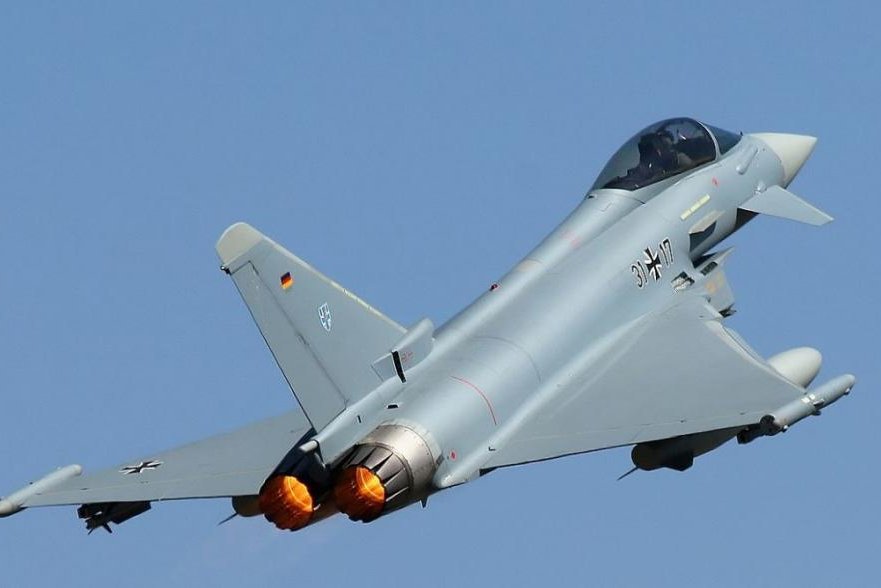$54 million study aims to improve Eurofighter Typhoon aircraft
19 June 2019
By Ed Adamczyk
A $54 million study to improve the performance of the Eurofighter Typhoon plane was announced in Paris on Wednesday. Photo by Krasimir Grozev/German air force

June 19 (UPI) -- Members of the Eurofighter Typhoon fighter program at the Paris Air Show on Wednesday signed a $54 million contract to conduct studies to improve the aircraft.
Eurofighter Jagdflugzeug GmbH, Eurojet Turbo GmbH and the NATO Eurofighter & Tornado Management Agency agreed to mutually support the long-term development of the combat aircraft.
The contract calls for a 19-month study of aircraft modifications and a nine-month study of adaptations of its EJ200 engine.
For the engine, range, persistence and longer component life cycles are the main areas of focus. A review of the plane will center on a redesigned cockpit with panoramic displays, high speed data networking capability, improved target data management systems and new outboard sensors.
The goal is development of a variant of the plane, built by a consortium of European companies and in service of several NATO countries since 1994, to maintain operational readiness and add to the platform's competitive edge for several decades.
"From this study we will look into operational effectiveness, interoperability and reduced costs, and fully exploit the full growth potential of the aircraft," Raffael Klaschka, head of marketing at Eurofighter GmbH marketing director, said on Wednesday.
The contract announcement comes as a mockup of the next Eurofighter plane, designed to make the Typhoon obsolete, was unveiled Monday at the air show.
Spain joined France and Germany in a project to build the next generation of fighter jets, and defense ministers from all three countries signed a framework agreement initiating their trilateral cooperation.
A prototype of the new plane is expected by 2026, with a replacement of the Typhoon and France's Rafale aircraft by 2040.

 www.upi.com
www.upi.com
19 June 2019
By Ed Adamczyk
A $54 million study to improve the performance of the Eurofighter Typhoon plane was announced in Paris on Wednesday. Photo by Krasimir Grozev/German air force
June 19 (UPI) -- Members of the Eurofighter Typhoon fighter program at the Paris Air Show on Wednesday signed a $54 million contract to conduct studies to improve the aircraft.
Eurofighter Jagdflugzeug GmbH, Eurojet Turbo GmbH and the NATO Eurofighter & Tornado Management Agency agreed to mutually support the long-term development of the combat aircraft.
The contract calls for a 19-month study of aircraft modifications and a nine-month study of adaptations of its EJ200 engine.
For the engine, range, persistence and longer component life cycles are the main areas of focus. A review of the plane will center on a redesigned cockpit with panoramic displays, high speed data networking capability, improved target data management systems and new outboard sensors.
The goal is development of a variant of the plane, built by a consortium of European companies and in service of several NATO countries since 1994, to maintain operational readiness and add to the platform's competitive edge for several decades.
"From this study we will look into operational effectiveness, interoperability and reduced costs, and fully exploit the full growth potential of the aircraft," Raffael Klaschka, head of marketing at Eurofighter GmbH marketing director, said on Wednesday.
The contract announcement comes as a mockup of the next Eurofighter plane, designed to make the Typhoon obsolete, was unveiled Monday at the air show.
Spain joined France and Germany in a project to build the next generation of fighter jets, and defense ministers from all three countries signed a framework agreement initiating their trilateral cooperation.
A prototype of the new plane is expected by 2026, with a replacement of the Typhoon and France's Rafale aircraft by 2040.

$54 million study aims to improve Eurofighter Typhoon aircraft - UPI.com
Members of the Eurofighter Typhoon fighter plane program at the Paris Air Show on Wednesday signed a $54 million contract to conduct studies to improve the aircraft.

